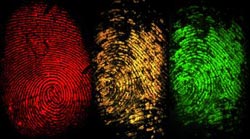Fingerprints Tell All

It has long been well established that fingerprints can be used to identify people or help convict them of crimes. Things have gone a lot further now: fingerprints can be used to show that a suspect is a smoker, takes drugs, or has handled explosives, among other things. In the journal Angewandte Chemie, Pompi Hazarika and David Russell describe the noteworthy progress that has recently been made.
When a finger touches a surface, sweat and oil-containing substances like sebum leave behind a print that is invisible to the naked eye. There are several ways to make it visible, like dusting with powder or spraying with reagents or “superglue”. A new technique that improves sensitivity involves the deposition of gold nanoparticles attached to cage-like molecules filled with dyes or other luminescent makers that cause the fingerprint pattern to glow. Gold nanoparticles attached to antibodies against amino acids are better at revealing older, dried fingerprints.
If a person has taken drugs, traces are released in his or her sweat. A team working with Russell at the University of East Anglia (Norwich, UK) has recently developed a method by which magnetic particles are equipped with antibodies that bind specifically to certain drug or nicotine metabolites.
In a second step, they apply a fluorescent antibody, which binds to the first antibody and indicates the presence of the corresponding drug by glowing under a fluorescence microscope. By using this method, the researchers were able to simultaneously detect several different narcotics in a single fingerprint.
Other innovative approaches use chromatographic and mass spectrometric techniques to identify the components of sweat and their decomposition products in fingerprints. One exciting development is the use of desorption electrospray ionization mass spectrometry (DESI). Charged droplets of solvent are sprayed onto the surface, forming a film that dissolves materials out of the fingerprint.
Additional solvent droplets impact the film and release the dissolved analytes from the surface so that they can be analyzed by mass spectrometry. An image of the fingerprint is then computed. Traces of drugs and explosives can also be shown.
Another interesting technique is infrared spectroscopy, which has been used to separate overlapping fingerprints from two individuals by means of their different sebum contents to produce two separate images. It is also possible to detect traces of explosive. Raman spectroscopy can be used to identify pharmaceuticals like aspirin and paracetamol (acetaminophen), as well as caffeine and starch in fingerprints.
The goal is to develop a cost-effective, rapid, portable, miniature system that can detect fingerprints and the chemical components in them. This would not only be useful for criminologists, but also for doping tests and diagnostics.
About the Author
David Russell is Professor of Chemistry at the University of East Anglia, Norwich, UK. His research is currently focused on the synthesis and functionalisation of nanoparticles. These functionalised particles are used for the development of in vitro diagnostics, intracellular measurement of target analytes and for the delivery of photosensitisers for photodynamic cancer therapy.
Author: David Russell, University of East Anglia, Norwich (Großbritannien), http://www.uea.ac.uk/che/dar
Title: Advances in Fingerprint Analysis
Angewandte Chemie International Edition, Permalink to the article: http://dx.doi.org/10.1002/anie.201104313
Media Contact
All latest news from the category: Life Sciences and Chemistry
Articles and reports from the Life Sciences and chemistry area deal with applied and basic research into modern biology, chemistry and human medicine.
Valuable information can be found on a range of life sciences fields including bacteriology, biochemistry, bionics, bioinformatics, biophysics, biotechnology, genetics, geobotany, human biology, marine biology, microbiology, molecular biology, cellular biology, zoology, bioinorganic chemistry, microchemistry and environmental chemistry.
Newest articles

High-energy-density aqueous battery based on halogen multi-electron transfer
Traditional non-aqueous lithium-ion batteries have a high energy density, but their safety is compromised due to the flammable organic electrolytes they utilize. Aqueous batteries use water as the solvent for…

First-ever combined heart pump and pig kidney transplant
…gives new hope to patient with terminal illness. Surgeons at NYU Langone Health performed the first-ever combined mechanical heart pump and gene-edited pig kidney transplant surgery in a 54-year-old woman…

Biophysics: Testing how well biomarkers work
LMU researchers have developed a method to determine how reliably target proteins can be labeled using super-resolution fluorescence microscopy. Modern microscopy techniques make it possible to examine the inner workings…





















